
Simca was a French automaker, founded in November 1934 by Fiat S.p.A. and directed from July 1935 to May 1963 by Italian Henri Pigozzi. Simca was affiliated with Fiat and, after Simca bought Ford's French subsidiary, became increasingly controlled by Chrysler. In 1970, Simca became a brand of the Chrysler's European business, ending its period as an independent company. Simca disappeared in 1978, when Chrysler divested its European operations to another French automaker, PSA Peugeot Citroën. PSA replaced the Simca brand with Talbot after a short period when some models were badged as Simca-Talbots.
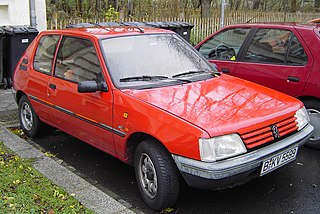
The Peugeot 205 is a supermini (B-segment) car produced by the French manufacturer Peugeot from 1983 to 1999.
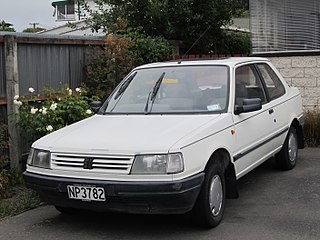
The Peugeot 309 is a small family car that was manufactured between 1985 and 1994 in England, Spain and France by PSA Peugeot Citroën. It was originally intended to be badged as a Talbot and, as development progressed, to be called the Talbot Arizona.
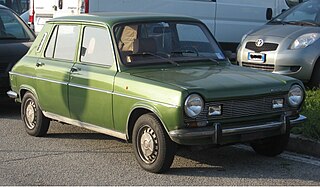
The Simca 1100 is a car built from 1967 to 1982 by Simca. It was replaced by the Simca-Talbot Horizon.

The Panhard PL 17 is an automobile made by the French manufacturer Panhard from 1959 until 1965. Presented on 29 June 1959, as successor to the Panhard Dyna Z, the PL 17 was developed from the older car, but with an much more streamlined body than its predecessor. The four-door saloon was joined by the Cabriolet in 1961, and by the Break, a five-door estate version, in April 1963. The Break, developed by Panauto, sat on a longer wheelbase but was of the same overall length. It was built in very small numbers, only about 2,500 being produced overall.

The Simca Poissy engine, commonly known as the Simca 1100 engine, was a four-cylinder Overhead valve engine developed by Simca for use in its superminis and economy cars, designed by the engineer Georges Martin. In spite of its common name, the engine actually predates the Simca 1100 model, and debuted in 1961 in the Simca 1000 Coupé. It was developed and produced by Simca in the late 1960s at the manufacturer's factory in Poissy, hence its name.

The Chrysler 180 was the base name for a series of large saloon cars produced by Chrysler Europe. Resulting from joining the development efforts of Rootes Group and Simca, the car was produced from 1970 to 1975 in Poissy, France, and later in Chrysler's subsidiary Barreiros' factory in Spain. The Chrysler 180 was also the base for the medium-sized model built by Chrysler Australia, the Chrysler Centura.

The Simca Vedette is a large car, manufactured from 1954 to 1961 by French automaker Simca, at their factory in Poissy, France. The Vedette competed in France's large car market at a time when the economy was finally returning to growth, and enjoyed moderate success with its American style finished off by the Italian designer Rapi. It was marketed with different model names according to trim and equipment levels. The Vedette was Simca's largest model at that time and it spawned a more economical version, the Simca Ariane.
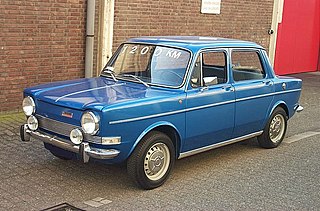
The Simca 1000 is a small, rear-engined, four-door saloon which was manufactured by the French automaker Simca from 1961 to 1978.

The Simca Ariane is a large saloon car launched in April 1957 by the French automaker Simca and manufactured in the company's factory at Poissy until 1963.
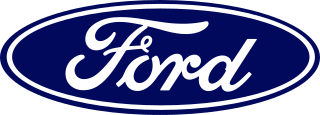
Ford France is the French subsidiary of the American automaker Ford Motor Company, which existed under various names between 1916 and 1954, when Ford sold the manufacturing business to Simca.

The Simca 1300 and Simca 1500 were large family cars manufactured by the French automaker Simca in its Poissy factory from 1963 to 1966 and between 1966 and 1975 in revamped versions, as the Simca 1301 and 1501.

The Simca Aronde is an automobile which was manufactured by the French automaker Simca from 1951 to 1964. It was Simca's first original design, as well as the company's first unibody car. "Aronde" means "swallow" in Old French and it was chosen as the name for the model because Simca's logo at that time was a stylized swallow.

The Simca 9 is a French sports car produced by French automaker Simca. It first appeared in June 1952 and was built until 1954. It was a development of the Simca 8, from which it differed by being lengthened a bit between the rear edge of the door and the bulge of the rear fender, to provide more interior room. More importantly, the 9 Sport was of a unibody design. This meant that the car was not offered as a convertible, although a small number of 9 Sport convertibles were built, using the chassis of the earlier 8 Sport. The mechanics were the same as for the Simca Aronde, although the engine was upgraded from 45 to 50 CV . Its running gear was similar to that of the Simca 8 Sport, with the same iteration of the engine, benefitting from a higher compression ratio. The car was built by Facel-Métallon in Colombes. In September 1952, the 1953 Simca 9 Sport featured all-new bodywork, curvier and with more glazing. Again, it featured steel bodywork of Facel's manufacture, and, again, it was heavier and thus no faster than the Aronde sedan on which the expensive Sport was based. A single convertible prototype was built. For model year 1954 the only difference was redesigned hubcaps with a stylized "S". The 9 Sport name was then retired as of September 1954. For 1955 the car was renamed the Simca Coupé de Ville, with full equipment and downplaying the "sport" aspect.

The Ryton plant is a former car manufacturing plant in Ryton-on-Dunsmore, England. Developed by the Rootes Group as a shadow factory in 1939 to produce aircraft engines for World War II; post war it became the headquarters of the group.
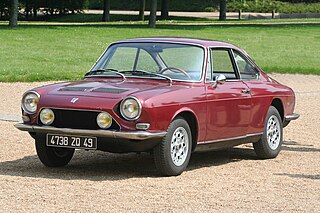
The Simca Coupé 1000 and its successor, the Simca 1200S are small, rear-engined two-door coupés which were produced by Simca between 1962 and 1971. Simca also provided the engine and the mechanical underpinnings while the small elegant bodies were built in Turin by Bertone before being transferred for final assembly to Simca's Poissy plant and an assembly plant in Rotterdam on specially configured trains.
The Stellantis Poissy plant is a French car plant belonging to Stellantis located in Poissy, Yvelines. It is dedicated to the manufacturer's Platform 1 cars, which are cars in the subcompact class, with an annual output of approximately 200,000 cars.
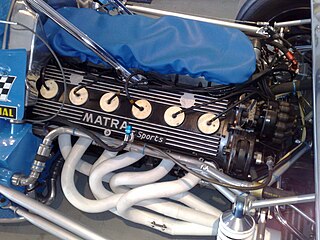
The Matra Sports V12 engine is an automotive internal combustion engine for sports car endurance racing and Formula One. It won the 24 Hours of Le Mans three times.
The Simca Type 342 and 345 Engines were four-cylinder OHV engines, produced from 1963 through 1975, and used in the Simca mid-size 1501/1301 chassis. It was developed and produced by Simca in the early 1960s to be used in the Simca 1500.

Thames was a commercial vehicle brand produced by Ford of Britain.

















